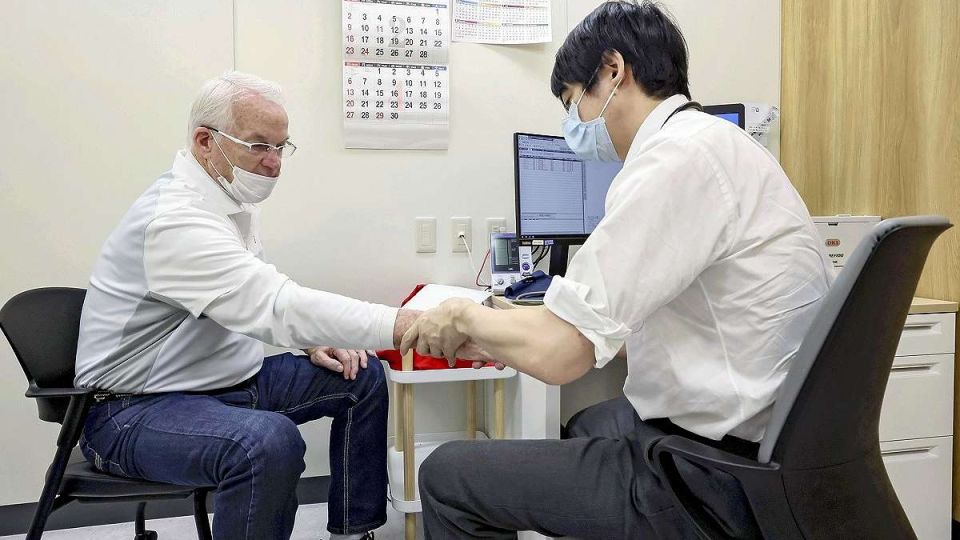May 21, 2025
TOKYO – With the increase in foreign visitors and residents in Japan, a growing number of medical institutions have taken steps to ensure smooth treatment and avoid problems, including using interpreters.
The number of medical institutions listed by the government as being cooperative in accepting foreign patients has increased 50% since 2019, when such data began to be regularly published.
The government, however, plans to take measures to improve the situation further because there are disparities in efforts between regions and medical institutions due to financial difficulties and other reasons.
Doctors with overseas experience
In mid-February, Ronald Nichols, a 67-year-old American who said he injured his back while playing golf, was examined by Ryuichiro Sasae, 44, at NTT Medical Center Tokyo in Shinagawa Ward, Tokyo.
Sasae, who speaks fluent English, prescribed a sleeping medication to Nichols, who said he wakes up in the middle of the night recently because of the pain. The doctor also advised him to lose some weight. Nichols said it was very helpful that Sasae considered with him ways to ease his pain and worries.
The hospital, which has about 600 beds, established in 2020 the Department of International Healthcare to treat non-Japanese patients. Sasae and other doctors with extensive experience working at hospitals overseas serve as general practitioners who treat a wide range of illnesses and injuries. They also have their patients treated by specialists as needed. In addition, there are staff on hand who can communicate with overseas insurance companies.
Last year, there were about 12,000 visits by foreign outpatients to the hospital.
“We want to further improve our preparations so that foreign nationals can feel at ease,” Sasae said.
List of cooperative institutions
The number of foreign nationals visiting or living in Japan continues to rise due to the promotion of Japan as a tourism-oriented country and the admission of international workers. The annual number of visitors to Japan has reached about 36.87 million, and the number of foreign residents has hit about 3.77 million.
In response to these developments, the government began efforts to create an environment in which foreigners can receive medical care with peace of mind. In July 2019, the government started publishing a list of medical institutions that are cooperative in accepting foreign patients and have been certified by each prefecture as meeting the necessary criteria.
The number of medical institutions listed initially tallied about 1,600, but the figure increased to 2,455 as of April 24. The list, which includes information on the languages and cashless payment services each institution can accommodate, is available on the websites of the Health, Labor and Welfare Ministry and the Japan National Tourism Organization.
The ministry has created a manual for medical institutions that includes guidelines for establishing interpretation services. It also encourages prefectures to establish councils where local governments, medical institutions and accommodations facilities can discuss measures to strengthen the acceptance of foreign patients, while subsidizing half of relevant operating costs.
The Osaka prefectural government, which is hosting the 2025 Osaka-Kansai Expo, has been holding regular council meetings since 2018, utilizing the subsidies. Anticipating a large number of foreign visitors to the Expo, the prefecture has been studying measures to strengthen emergency response systems within the prefecture and heatstroke countermeasures at the event venue.
Monetary incentives needed
However, initiatives by local governments are lacking in scope. Only 17 prefectures have established such councils.
“We were unable to focus on strengthening the measures to accept foreign patients because we were busy with handling the COVID-19 pandemic,” a local government official said.
In addition to rising prices and labor costs, medical institutions are facing a tendency for people to refrain from visiting medical facilities during and after the pandemic.
A nationwide survey conducted by the Japan Hospital Association and others last year found that 53.4% of hospitals in Japan operated in the red in fiscal 2023, more than double the percentage from the previous year at 23%. Some doctors voiced concern, saying that monetary incentives are needed to motivate health care providers to treat foreign patients because they lack the resources to improve their preparations.

